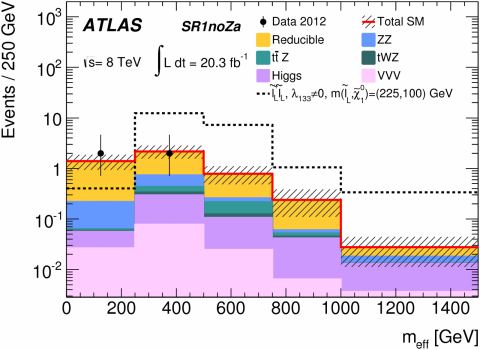

The mathematical notion of symmetry is used to simplify the equations and to categorize the constituents and interactions of theories describing the natural phenomena. Physicists are constantly on the lookout for new symmetries when they confront new phenomena at the physics frontiers. One such mathematical symmetry is so-called "supersymmetry" (SUSY), which has been proposed to extend the very successful Standard Model of elementary particles.
According to SUSY, every known particle in the Standard Model should have a so-called superpartner particle, or "sparticle." SUSY is regarded as one of the most promising Standard Model extensions since it offers answers to some fundamental questions about our Universe: What is the nature of dark matter? Do forces of nature combine into one superforce at very high energies? Can the mass of the (recently discovered) Higgs boson be calculated sensibly when including corrections from quantum mechanics?
Some SUSY sparticles are expected to have masses–a few hundred GeV, or billions of electron volts, such that they could be created at the Large Hadron Collider (LHC) accelerator at CERN in Geneva. These are the partners of the known Higgs, W, and Z boson particles called charginos and neutralinos. The direct production of charginos and neutralinos are considered highly promising (or "golden") channels for the discovery of SUSY.
The ATLAS Collaboration at the LHC has just released three search analyses addressing the production of charginos and neutralinos. These comprehensive analyses are sensitive to a variety of different formulations of the SUSY model, including those where the heavy neutralino decays into a Higgs boson and a special sparticle that could be the mysterious dark matter particle. TRIUMF, in close collaboration with UBC, pioneered such SUSY searches in the early LHC data and have since developed it to yield high sensitivity in the full LHC Run 1 data set. As of yet, no signals for the existence of SUSY have been seen in the LHC data, though analyses like these are starting to strongly constrain what the sparticle masses cannot be and which SUSY formulations are still viable or not.
Estel Perez Codina and Zoltan Gecse, postdoctoral researchers with the TRIUMF and UBC ATLAS groups respectively, were the driving force within the ATLAS teams. Graduate students Matthew Gignac and Samuel King played a key role in the research and continue to do so in preparation for the upcoming LHC run beginning Spring 2015, which will be at a much higher energy than the previous runs and will give ATLAS scientists a greater chance of discovering SUSY.
Figure captions:
(Top) Summary of ATLAS searches for production of charginos and neutralinos with 20.3 - 20.7 fb−1 of pp collision data at LHC energy sqrt(s) = 8TeV. The region below the curves outlines potential chargino and neutralino masses so far EXCLUDED by the data.
(Bottom) The "effective mass" distributions (in GeV) expected for "chargino-like" and "neutralino-like" events (dotted line) compared to the Standard Model expectation (red line with uncertainty region shown hashed) from similar-looking events not involving SUSY. Both the statistical and systematic uncertainties are included in the shaded bands. One sees that data agree with the Standard Model predictions and is not compatible with the selected SUSY scenario.
–Prepared by Anadi Canepa and Marcello Pavan
For more:
http://arxiv.org/abs/1402.7029, JHEP 04 (2014)169
http://arxiv.org/abs/1403.5294 (accepted by JHEP)
http://arxiv.org/abs/1405.5086 (submitted to Phys. Rev. D.)
CERN Courier:
http://cerncourier.com/cws/download/Jun14
